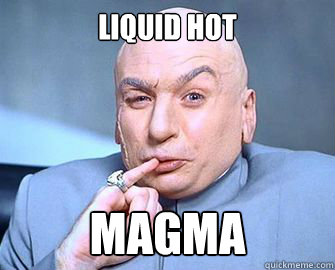
Posted on 04/23/2015 3:19:16 PM PDT by BenLurkin
Then again, such a ploy might result in several hundred years of acid rain, denuding the continent of all vegetation.
The continental crust is typically from 30 km (20 mi) to 50 km (30 mi) thick and is mostly composed of slightly less dense rocks than those of the oceanic crust.
Below the crust is the Earth’s mantle. In the mantle, temperatures range between 500 to 900 °C (932 to 1,652 °F) at the upper boundary with the crust; to over 4,000 °C (7,230 °F) at the boundary with the core.
The mantle is in a solid form due to high pressure, but if at the surface is in the form of magma. So technically, don’t we ALL sit over an ENORMOUS pool of magma 45 km’s deep, and not just at Yellowstone?
2012
Okay, I’ll bite. Where would the acid come from? Since there would be no direct contact between the water and the magma, just water and very hot rock, once a limited amount of sulfur has been leached out of them, the steam should be pretty clear.
The idea of the water is that it should remove a lot of heat from one side of the magma, which in turn would lower the upwell pressure.
Yellowstone supervolcano keeps getting bigger, new U. study finds
By Amy Joi O’Donoghue
April 24th, 2015 @ 8:54am
...
“For the first time, we have imaged the continuous volcanic plumbing system under Yellowstone,” said first author Hsin-Hua Huang, a postdoctoral researcher in geology and geophysics. “That includes the upper crustal magma chamber we have seen previously, plus a lower crustal magma reservoir that has never been imaged before and that connects the upper chamber to the Yellowstone hotspot plume below.”
...
Farrell added that even though the large reservoir of magma has always been there, grasping the scope of its size can be a bit daunting.
“Yellowstone is a really big volcano,” he said. “Some of these things are on scales that we have not seen before.”
...
Sounds like the spot Oklahoma, Texas, and Kansas need to start disposing of water used in the fracking process....

Any time we heat up water to produce steam, we also frequently transport ionic compounds of the dissolved compounds in that hot environment. This is even greater for superheated fluids when they vaporize. While solutes generally don’t reach the temperatures and remain in solution when the water boils, increasing their concentrations in the remaining water, they then cause different chemical concentrations in the solvents.
The inverse occurs with injection wells, which tend to calcify or plug up if the water chemistry isn’t well controlled.
Dante's Peak - because Linda Hamilton was in it.
I thought Volcano was cheesy and that stupid sub-plot about the black and white persons going at it.
From some of the stuff I have read it’s supposed to be like Krakatoa; except bigger, a LOT bigger.
I would expect the blast effect and some big rocks and a certain amount of ash would get into Idaho, Utah, Nevada, Colorado an d Montana.
Dante’s Peak has some of the greatest bad movie lines ever. I’m talking jaw-droppingly bad.
http://www.imdb.com/title/tt0118928/quotes
But the greatest was when the volcano had erupted, and they are driving down the side of the volcano in a pickup truck, and have no choice but to drive across a river of lava.
Halfway across, tires burning, children screaming, they see, on a rock island in the middle of the lava flow, their dog, Ruffy.
“Jump! Ruffy! Jump!”
And the dog makes a prodigious leap, landing safely in the back of the pickup truck.
Ever since then, the expression “JRJ” has meant to me the sum total of bad writing ever to have emerged from Hollywood.
https://www.youtube.com/watch?v=r421zjv-hoE
Disclaimer: Opinions posted on Free Republic are those of the individual posters and do not necessarily represent the opinion of Free Republic or its management. All materials posted herein are protected by copyright law and the exemption for fair use of copyrighted works.